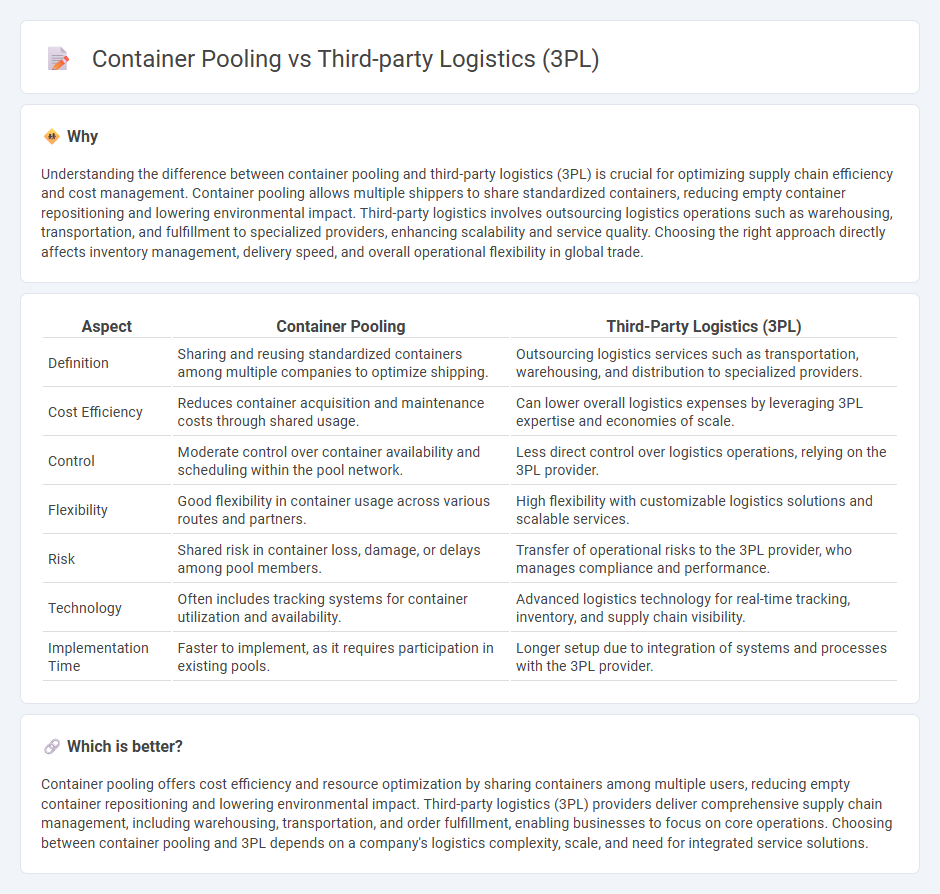
Container pooling reduces shipping costs and environmental impact by sharing standardized containers among multiple shippers, improving asset utilization and supply chain efficiency. Third-party logistics (3PL) providers offer comprehensive supply chain services including transportation, warehousing, and inventory management, enabling companies to focus on core business activities. Explore the advantages and trade-offs of container pooling versus 3PL to optimize logistics strategies.
Why it is important
Understanding the difference between container pooling and third-party logistics (3PL) is crucial for optimizing supply chain efficiency and cost management. Container pooling allows multiple shippers to share standardized containers, reducing empty container repositioning and lowering environmental impact. Third-party logistics involves outsourcing logistics operations such as warehousing, transportation, and fulfillment to specialized providers, enhancing scalability and service quality. Choosing the right approach directly affects inventory management, delivery speed, and overall operational flexibility in global trade.
Comparison Table
| Aspect | Container Pooling | Third-Party Logistics (3PL) |
|---|---|---|
| Definition | Sharing and reusing standardized containers among multiple companies to optimize shipping. | Outsourcing logistics services such as transportation, warehousing, and distribution to specialized providers. |
| Cost Efficiency | Reduces container acquisition and maintenance costs through shared usage. | Can lower overall logistics expenses by leveraging 3PL expertise and economies of scale. |
| Control | Moderate control over container availability and scheduling within the pool network. | Less direct control over logistics operations, relying on the 3PL provider. |
| Flexibility | Good flexibility in container usage across various routes and partners. | High flexibility with customizable logistics solutions and scalable services. |
| Risk | Shared risk in container loss, damage, or delays among pool members. | Transfer of operational risks to the 3PL provider, who manages compliance and performance. |
| Technology | Often includes tracking systems for container utilization and availability. | Advanced logistics technology for real-time tracking, inventory, and supply chain visibility. |
| Implementation Time | Faster to implement, as it requires participation in existing pools. | Longer setup due to integration of systems and processes with the 3PL provider. |
Which is better?
Container pooling offers cost efficiency and resource optimization by sharing containers among multiple users, reducing empty container repositioning and lowering environmental impact. Third-party logistics (3PL) providers deliver comprehensive supply chain management, including warehousing, transportation, and order fulfillment, enabling businesses to focus on core operations. Choosing between container pooling and 3PL depends on a company's logistics complexity, scale, and need for integrated service solutions.
Connection
Container pooling enhances efficiency in third-party logistics (3PL) by providing shared access to standardized containers, reducing costs and improving asset utilization. 3PL providers leverage container pooling to streamline supply chain operations, optimize transport logistics, and minimize empty container repositioning. This integration supports sustainable practices and increases flexibility in global freight management.
Key Terms
Outsourcing
Third-party logistics (3PL) providers offer comprehensive outsourcing solutions for supply chain management, including transportation, warehousing, and inventory control, streamlining operations for businesses. Container pooling involves the outsourced sharing and management of shipping containers among multiple companies to reduce costs and improve container utilization. Explore the benefits and differences of outsourcing in 3PL and container pooling to optimize your logistics strategy.
Asset Management
Third-party logistics (3PL) providers manage a broad range of supply chain functions, including inventory storage, transportation, and distribution, optimizing asset utilization through advanced tracking technologies and real-time data analytics. Container pooling involves shared container assets among multiple users, reducing capital expenditure and improving container lifecycle management by maximizing container usage and minimizing empty repositioning. Explore how integrating 3PL services with container pooling can enhance asset management efficiency and sustainability in your logistics operations.
Supply Chain Integration
Third-party logistics (3PL) providers manage various supply chain activities including warehousing, transportation, and inventory management, optimizing operational efficiency and reducing internal costs. Container pooling, on the other hand, involves shared use of standardized containers among multiple shippers, enhancing asset utilization and sustainability while lowering container-related expenses. Explore the benefits of integrating 3PL services with container pooling for a streamlined, cost-effective supply chain solution.
Source and External Links
What is 3PL (third-party logistics)? | Definition from TechTarget - A 3PL provider offers outsourced logistics services including management of procurement, fulfillment, transportation, and warehousing, allowing companies to focus on core activities by contracting supply and distribution services as needed.
What is a 3PL? Third-party logistics definition, process, and resources - Third-party logistics providers specialize in inventory management, warehousing, order fulfillment, returns processing, and transportation to optimize supply chains, reducing operational burdens and supporting business growth.
How 3PLs Revolutionize Logistics and Supply Chain Management - 3PLs outsource logistics and supply chain functions like transportation, warehousing, order fulfillment, and customs brokerage to specialized firms, enabling businesses to enhance efficiency, flexibility, and growth by leveraging external expertise and resources.
 dowidth.com
dowidth.com